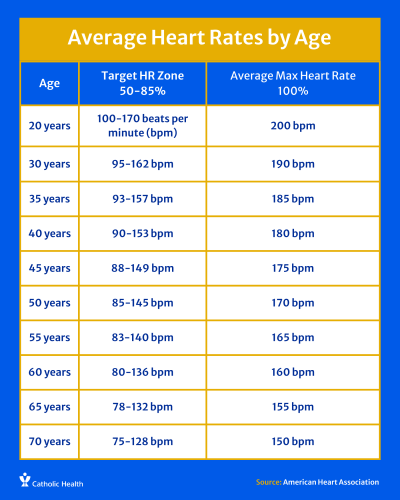“Measuring your heart rate is a helpful tool to monitor your overall health,” said Glenford Robinson, MD, Catholic Health Cardiologist. “It ensures you exercise at the right intensity for maximum benefit.”
Dr. Robinson explained that knowing your target heart rate helps keep your heart in an ideal range without overexerting. “It enables you to reach personal goals such as losing weight and increasing endurance,” he said.
What is a heart rate?
Your heart rate is the number of times your heart beats per minute (bpm) and varies depending on several factors, including:
- Age
- Level of physical activity
- Level of stress and anxiety
- Medication use
- History of heart disease
- Body position
- Air temperature
- Stimulants like caffeine and nicotine
Heart rate is not the same as your pulse, which is how you can feel and measure your heart rate.
What is a resting heart rate?
“Lower is better for a resting heart rate because your heart does not have to work as hard to maintain a steady beat,” said Dr. Robinson.
A resting heart rate is when the heart pumps the lowest amount of blood needed when you are not exercising. A resting heart rate typically ranges between 60 and 100 beats per minute when you are sleeping, sitting, relaxed and not ill.
A resting heart rate below 60 beats per minute is typical for people on certain medications, such as beta-blockers, and those who are athletes or engage in vigorous exercise.
Low-impact or moderate physical activity typically does not change a person’s average resting heart rate.
Is there a maximum heart rate?
Your maximum heart rate averages 220 minus your age. For example, if you are age 50, your maximum heart rate is 170 beats per minute.
What is a target heart rate?
“Start slow if you are beginning a new exercise program, aiming for the lower range of your target zone and then building to a higher range,” said Dr. Robinson. “Always check with your doctor before starting a new fitness routine.”
For moderate-intensity physical activities: The target heart rate is about 50%-70% of your maximum heart rate.
For vigorous physical activities: The target heart rate is about 70%-85% of your maximum heart rate.
How do I find my heart rate?
“Once you know your target heart rate, you can monitor your heart rate during physical activity to ensure you are in the zone,” said Dr. Robinson. “You can also monitor your resting heart rate, preferably after waking up.”
A wearable fitness tracker is a helpful and easy way to keep track of your heart rate, but you can also measure it manually.
Finding your pulse is easiest using your wrist (radial artery) or the side of your neck (carotid artery). You can also use other areas, such as the inside of your elbow (brachial artery).
When you detect throbbing, lightly place the tips of your first two fingers (not your thumb) over the artery. Count the number of beats in 60 seconds for the most accurate reading.
How Heart-Healthy Are Your Habits?
What if I am concerned about my heart rate?
Contact your doctor if you experience any of the following as it may indicate a potential health risk:
- A heart rate that is consistently too fast or too slow.
- A heart rate that frequently skips.
- Heart flutters or palpitations.
- A vibrating sensation (called a “thrill”) instead of a single thump when you take your pulse.
Explore Catholic Health cardiology services.







